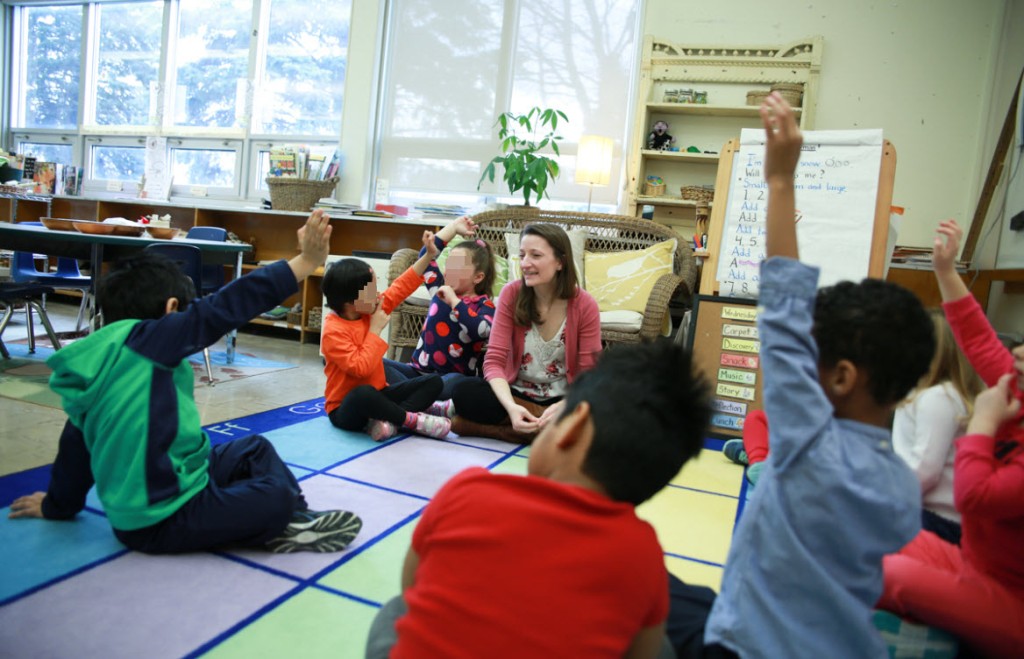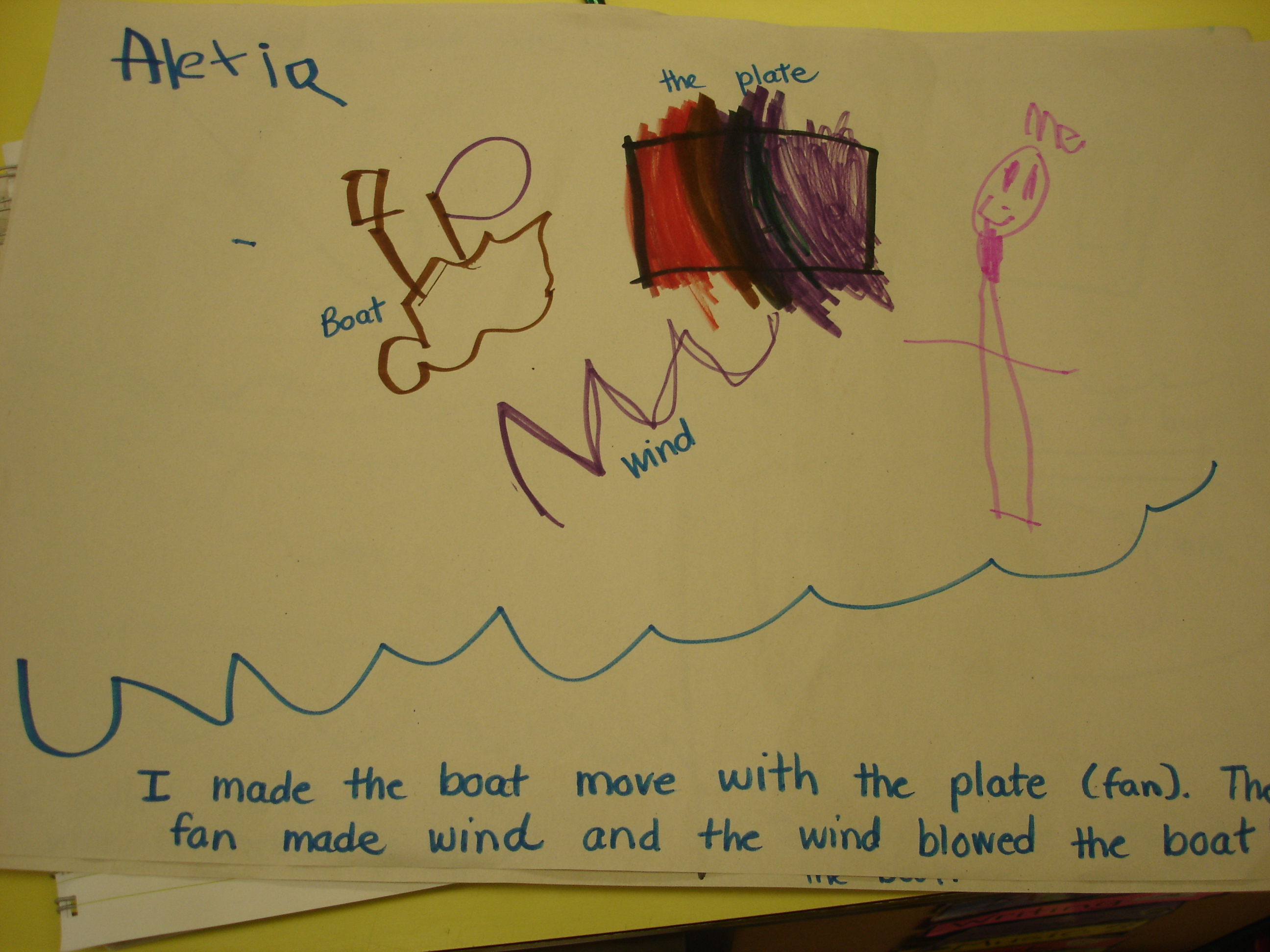
I have been teaching kindergarten for over 10 years, and in that time, my program has evolved a lot! Actually, it continues to change and evolve each year as I connect with other educators, read professional resources, and collaborate with my students and their families. Without a doubt, the most important change I made to my classroom schedule when I embarked on an inquiry-based approach was adding in time to reflect daily with my students. I jokingly refer to reflection time as “free advertising” because it is the time when we can highlight the important learning goals/thinking routines/discoveries we want the children to be demonstrating, through the children’s own work. The decision about which children share is not random, but purposeful. Perhaps it might be a student who made a breakthrough or did their personal best, or it may be a child sharing an interesting way they interacted with materials at one of our provocations, or it may be a child sharing a problem they encountered while working and the class is invited to help them brainstorm a solution. Whatever the reason, the discussion that occurs during reflection time is what drives our classroom learning. Much of my planning for next steps is derived from our reflection conversations and the children are often involved in suggesting new materials or centres that would help with our inquiries. What I like about reflection time is that it is collaborative. While I sometimes help the children with their sharing (especially at the beginning of the year), reflection time is a part of the day that the children begin to take real ownership over. Listening to them talk about what they’ve done, how they got their ideas, and what inspires them, I am constantly reminded of all the curiosity, knowledge, and determination each student possesses. I continue to be amazed by how thoughtful the children are in their questions and comments. They often speak of being ‘inspired’ by things they saw their classmates doing. I am often inspired too!


Last week the Ministry of Education in Ontario came out with an addendum to the Full Day Kindergarten Curriculum document. In it was a new phrase: “noticing and naming the learning,” which caught my eye immediately:
From Growing Success – The Kindergarten Addendum (2016):
“Noticing and naming the learning” in terms of learning goals and success criteria is a way in which educators can create a picture for children of what and how they are learning, and support them in moving forward, no matter what their developmental level. As the children participate in and reflect on a variety of learning experiences, they develop and deepen their understanding of what their learning looks like and what their next steps in learning might be. With educator support, children begin to participate in “noticing and naming the learning” and so contribute to their own, and their peers’, learning.
This “noticing and naming the learning” is a crucial part of the educator’s role in helping children understand what it is they are learning and why it is important. In a play-based program, much of our learning together hinges on the conversations we have while children are engaging with materials at centres. Reflection time is crucial for sharing those learning moments with the larger classroom community.
The other aspect to this discussion that I think is important is the idea that noticing and naming the learning “support[s] [children] in moving forward, no matter what their developmental level.” This is an important element to reflection time as well. We are sharing and discussing work that reflects a variety of learning stages. The children learn that we all work at our own pace and all progress, however small, can be a cause for celebration. I still remember one ELL student I had who did not speak a word in English all year…until one day she made a drawing on the light table that she wanted to share. The class was SO supportive at her first attempt to speak in front of the class and after she spoke about her drawing they clapped! They were all so proud of her breakthrough and they knew what a big step it was for her to share her learning with the class. This is the kind of supportive culture a reflective classroom can create.
If you want to do some further reading about the importance of creating a culture of thinking, I recommend this article on the KQED website that references the work done by Project Zero senior research associate Ron Ritchhart.
When Kids Have Structure for Thinking Better Learning Emerges
Do you take time to reflect daily? How do you feel the notion of “noticing and naming the learning” in the new document will change the way you communicate with your students?

Thanks for sharing! Amazing ideas!
Nuzhat Khan-Noreen RECE St. Thomas More Elementary Twitter: @NoreenNuzhat @KAalligators2
” God, His angels and all those in Heavens and on Earth, even ants in their hills and fish in the water, call down blessings on those who instruct others in beneficial knowledge”.(Hadith)
On Apr 9, 2016 8:34 PM, “The Curious Kindergarten” wrote:
> msmcdonell posted: ” I have been teaching kindergarten for over 10 years, > and in that time, my program has evolved a lot! Actually, it continues to > change and evolve each year as I connect with other educators, read > professional resources, and collaborate with my students a” >
Amazing. I have just started an ‘end of day jar’. Not my own idea but my girls ask for the question at about 8am. It is helping to create a sense of community within the classroom. The resource is available on Pinterest.
Do you pick who shares each day? or only if they offer? We let our class volunteer, but now we have at least 10 kids each day who would share everyday if they could. Sometimes, its not purposeful as you said, its just because they like sharing.
Hi Nicole! Yes, we choose students to share who we think have something purposeful to demonstrate. Sometimes that just means giving a child the chance to express themselves in front of the larger group (e.g., give a typically quiet child the chance to show something they are excited about). Usually, we highlight work or learning that we want to see our kids doing – so if we put out a new centre we might highlight the work from there so the other kids understand what is happening there. Or if a child chooses to draw or write at a centre (e.g., draw a picture of a tower they made, write down a wondering about an object at the science table,etc.) we will showcase that.
Pingback: The First Day of School | The Curious Kindergarten
Pingback: Kindergarten in the Time of Covid-19 | The Curious Kindergarten